°Arcus°
Home » Creation stories » The Great Plains and Great Basin
CREATION STORIES FROM THE GREAT PLAINS AND GREAT BASIN
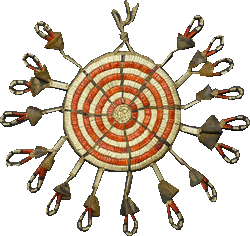
ARAPAHO
In the beginning, the earth was covered with water. Flat Pipe floated alone. The Great Spirit called down to him, telling him to fashion beings in order to bring about the creation of dry land. Flat Pipe created the first ducks from his thoughts, ordering them to dive down to the bottom of the sea to see what was there. This proved unsuccessful, leading to several other water birds also being created.
They too tried and failed, whereupon the Great Spirit suggested that an animal equally comfortable on land and water might prove more effective. Thus, Flat Pipe thought of Turtle. She dove down deep into the abyss, bringing back a piece of land which she spat out. This expanded, forming the earth, from which Flat Pipe made the first man and woman.

ARIKARA
In the beginning, Nishanu formed giants. These, however, had no respect for their creator, which led Nishanu to destroy them by means of flood. Of their number, only a few were preserved in the form of corn kernels in the earth. Nishanu had also planted corn in the sky, which produced Mother Corn.
Mother Corn descended to the earth to lead the people. The first people - who were more like the animals than humans of today - dug their way out, whereupon Mother Corn led them from the east to their later home.
Mother Corn's departure for the heavens, however, caused dissention among the humans, which led to warfare. This prompted her to return with a chief for the people, who was also named Nishanu after the deity in whose image he was created. Nishanu the chief taught the people to fight their enemies rather than among themselves, while Mother Corn instructed them in the religious ceremonies they were to observe.
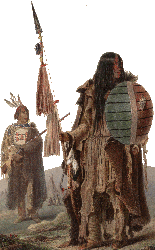
ASSINIBOINE
In the beginning, everything was water. Iktome, the creator and trickster hero, created a number of animals with the purpose of drawing up the first matter with which to create dry land. The muskrat was the only creature to succeed, at the cost of his life. Iktome found earth within muskrat's claws, with which he made land.
Iktome then decreed that there would be as many winter months as there were hairs on his robe. Frog pointed out that this would be too many, and suggested that seven would be enough. As a result of this impertinence, Iktome killed Frog, but - despite this - Frog's toes still suggested seven months, which led Iktome to acquiesce.
Thereafter, Iktome made people and horses from dirt, telling the ancestors of the Assiniboine how to purloin the steeds of their neighbours.
BLACKFOOT
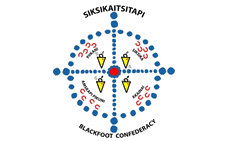
The Niitsítapi or Siksikaitsitapi, better known as the Blackfoot Confederacy, tell of Napi, the Old Man, who came from the south, forming mountains, forests and prairies and populating them with all manner of animals.
He made the Milk River and crossed it, laying down to rest on a hillock and marking his figure with stones. He proceeded northwards, stumbling over a knoll which became his Knees.
One day, he formed a woman and child from clay, telling them they must be people, then ordering that they awaken and rise. They walked down to the river with Napi, who told them of himself and his works.
CHEYENNE
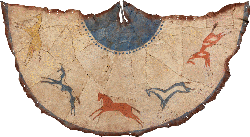
In the beginning, the Great Power made the earth, sky and the waters. In the furthest north, he fashioned a paradise abounding in fine food and drink where it was always warm, and in which the people and animals could understand one another, and lived together in harmony. There were various types of people, with the red people - those closest to the Great Power - living alongside white people and hairy people, the latter of whom dwelt in caves and remained wary of others. These eventually disappeared. The white people, meanwhile, were wily.
Eventually, the Great Power advised the red people to travel southward, teaching them how to feed and clothe themselves before they left. They lived for some time successfully, before the Great Power sent a warning that a flood was coming. As such, they were to migrate back to the former country in the north to escape its deleterious effects. However, they discovered that they were no longer able to communicate with the animals.
Thereafter, the red people again retraced their southward journey. Another flood, however, put paid to their unity, separating them into disparate tribes. Some tried to escape to the north again, but found their former domain a wasteland. Earthquakes and volcanoes almost destroyed them, before the Great Medicine Man in the sky sent corn and bison to allow them to survive.
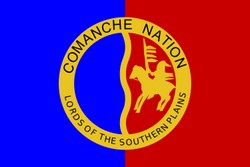
COMANCHE
The Great Spirit began the work of creation by gathering swirls of dust from the four cardinal directions, with which he made the Comanche. They lived on earth, but were initially compelled to share it with a shape-shifting demon, which caused them much grief. As a result, the Great Spirit cast the demon into a bottomless pit. The demon, however, managed to find a means to harm humans still: it sought refuge in the venomous weaponry of poisonous animals, through which it causes harm to people whenever the opportunity arises.
CROW (APSÁALOOKE)

In the beginning, all was water and darkness. Old Man came into the world and saw the wretched conditions which prevailed. He noticed in the distance the red eyes of two ducks swimming within the darkness. He beckoned them over to him and asked them about this place. Was there more to it than water and darkness? The elder of the ducks said that they knew somehow that there was something beneath the water, though they had never seen it.
To investigate further, Old Man sent Younger Duck down. After some time, he returned, bearing in his beak a root. Next, Elder Duck was dispatched to the bottom, and found a ball of mud. Old Man took the root and mud and blew upon it thrice. This caused the ball to grow, and it eventually displaced much of the water, forming a great land populated by animals and plants.
KÁÍNAWA (KAINAI)
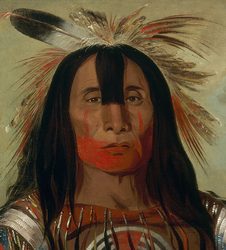
Napioa, the Old Man, floated upon the primordial waters on a long. He sent the fish, frog, lizard and turtle to the ocean floor to bring back material for creation. Only the turtle succeeded. Napioa rolled the mud the turtle had brought into a ball, which grew to become the earth. Thereafter, Napioa created all of the plants, animals and peoples of the earth, with the exception of the white man.
His final creations were people and bison. He made a woman, but put her mouth on the wrong way around. He had to correct this before creating the first men and further women. He then instructed them in the ways of the world. Last of all, he made the buffalo, and taught the people how to hunt them, before he took himself off into a far-off land in a southern sea.
KIOWA APACHE
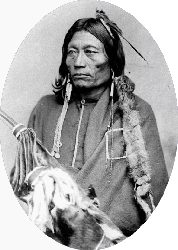
At the beginning of time, the universe was a dark place, into which a disk appeared. It was yellow and white at its sides and, within it, sat the small, bearded figure of Kuterastan, who is described as being the size of a frog. He awkoe and rubbed his eyes. Looking above, the darkness became filled with light at his gaze, which in turn illuminated the region below the disk. To the east, the light was yellow, while the light in the west had an amber hue. As Kuterastan looked around, clouds began to appear.
Again he rubbed his eyes and face, with the sweat from his hands forming another cloud, upon which sat the tiny figure of Stenatliha, the "Woman Without Parents." The pair looked at each other in confusion, wondering where they had come from. Again, Kuterastan rubbed his face, eyes and hands, which caused more sweat to dissipate, becoming the sun, Chuganaai, then Hadintin Skhin ("Pollen Boy").
After some time spent in silence, Kuterastan asked: -
This began the process of creation anew, forming Nacholecho the tarantula, then the Big Dipper, the winds, lightning and thunder. He then began to create the earth. The sweat of the four primordial figures he mixed in his hands, creating a tiny brown sphere no bigger than a bean. This gained in size as the gods kicked it around. The wind then entered it to inflate it, while Nacholecho attached a black cord to the ball and stretched it to the east, followed by a blue cord to the south, a yellow to the west and a white cord to the north. By this stage, the earth was a smooth plain. At this point, Kuterastan sang a song, with the lyrics: -
LAKOTA
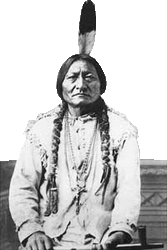
The Lakota know of another world which preceded this one. The people of the previous world, however, were ill behaved, causing the Creating Power to resolve to overthrow it and fashion a new earth. By the singing of certain sacred songs, he brought forth rain, which became stronger and stronger, while a fourth song caused the earth to split open, releasing more water and resulting in a disastrous flood.
The only survivor was Kangi the crow. He became tired and appealed to the Creating Power to give him a new place to rest. This prompted the creation of this world. From his pipe bag, the Creating Power drew out four of the many types of animals which he kept there. These were chosen for their ability to hold their breath under water for long periods of time, so they could draw up mud and other matter from the bottom of the flooded land. The loon was the first, but failed to reach the bottom. The otter and beaver also failed.
The last of the animals sent was Turtle, which remained beneath the water for so long that everyone was convinced that it had drowned, until it returned successful, bearing mud within its feet, claws and the gaps in its shell. The Creating Power, singing, then shaped this mud and spread it on the water, in order that he and Kangi could rest there. Thereafter, he shook eagle feathers, which caused the earth to spread and cover the waters. This dry land was made habitable by means of the Creating Power's tears, which provided fresh water resources. The land was then named as Turtle Continent in honour of Turtle, whose heroics made its creation possible.
The last part of the creation was the populating of this new land with the remainder of the animals from the pipe bag, before the Creating Power gathered red, white, black and yellow earth to create men and women. These were given the sacred pipe and told to live in the way he had ordained, lest they too end up drowning like their predecessors.
MANDAN
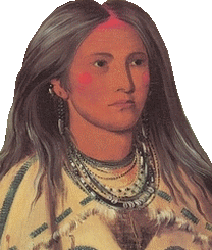
The Mandan nation tell of the First Creator and Lone Man.
A WORLD OF WATER
In the beginning, the earth was covered with water and enveloped by darkness. First Creator and Lone Man were walking together on the surface of the water when they saw a small duck. This they dispatched down to the ocean floor, from whence it brought up a beakful of sand. First Creator and Lone Man began to make use of this to form the earth.
First Creator began his work in the south, where he made the hill country, with its valleys watered by streams. Lone Man made the plains in the north, with its lakes and ponds. First Creator made the buffalo, deer and antelopes, while Lone Man made cattle and sheep.
Eventually, First Creator surveyed the land Lone Man had created. He was not impressed. There was nowhere to hide. Lone Man, however, resigned himself to the fact that his work was done and there was no changing it.
Thereafter, men and women lived on the land. Lone Man saw how they suffered, and desired to share in their lot. Thus, he entered some corn which a young girl was eating, causing her to become pregnant and subsequently give birth to him in human form. He was a good man, a peacemaker, who was beloved of the children in the girl's tribe. He taught his people a great many things.
However, the time came for him to depart. He told the people to raise a cedar trunk as a totem pole, paint it red and make offerings of incense to it, explaining that this was his body, whose presence would protect them.
First Creator, meanwhile, became a coyote.
A WORLD OF SAND
One day, Lone Man walked alone in a region of sand. He looked behind him and could see his tracks. He found a pipe before him, while a raven flew overhead. He wondered where he came from, so retraced his steps until he came to a spot of wet land, beyond which lay a vast lake. Beside the lake, there was a certain weed. The plant introduced herself as Lone Man's mother, with a buffalo bug leaping in the sand being his father. Lone Man's mother counselled him to return to the wet spot, where he would find a weed. This weed was to be used as medicine.
Thereafter, following his mother's instructions, Lone Man began to create the things within the world. He eventually met another man, First Creator, and the pair argued over who was eldest. Eventually, they began travelling together and came to another lake, where they saw two mud hens. These they tasked with bringing up mud from the bottom the lake. This they threw into the air, where it became a bird. Eventually, the animals were created - so many, in fact, that an old female frog told them that they would need to create death in order to prevent the overpopulation of the earth. Her child was the first to die.
The final step was to generate a more welcoming, less sandy world. They took the remaining mud and formed the topography of the Mandan country. Again, First Creator made the lands to the south, while Lone Man's creation were the flatlands of the north.
Eventually, First Creator transformed Lone Man into a coyote - and he still never discovered from whence he came.
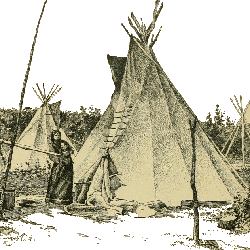
OMAHA
In the beginning, Wakonda, the Great Spirit, dwelt alone, with all of the life forms which were later to appear on earth mere spirits in his mind. They wished to incarnate themselves, but could only wander within the mind of Wakonda, the space between heaven and earth. Attempts were made to set up a home on the sun and moon, but these were abortive. Thereafter, they descended to the earth, where they found the world covered by water. They set out in each of the four directions, finding only more water. Suddenly, a rock emerged at the centre of the water and burst into flame, causing some of the water to evaporate and form clouds, which, in turn, caused more dry land to be revealed. The life forms then had somewhere to live, and they took physical form.
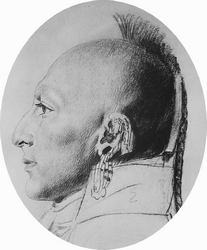
OSAGE
In the beginning, the people dwelt in the sky. Their parents were the sun and moon. Eventually the moon said they ought to come to the earth to live and they did, but found only water there. As a result, the helpless people floated in the air calling for help.
Eventually, the elk came to the aid of his fellows by allowing himself to fall into the water. Whilst sinking, he summoned the winds to blow away to waters to form dry land and mist. He rolled in the mud which was exposed and, from the hairs which were caught in the mud, the plants grew.
The first humans were the product of the mating of Snail Boy and Beaver Girl, who produced a son and daughter.
PAWNEE
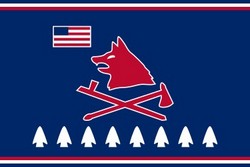
In the beginning, Tirawa or Tirawahat - space - began the work of bringing order to the cosmos. In the west, he placed the Sun and Evening Star, the mother of the people, while in the east he placed Moon and the brave Morning Star. Morning Star was wont to chase the star people from the skies into the west.
Next, Tirawa made four stars to support the four corners of the world in each of the cardinal directions. He then gave Evening Star wind, clouds, thunder and lightning, who danced and sang while Tirawa created the world.
Tirawa dropped a pebble into the clouds, which resulted in the precipitation of water. The four supporters of the earth struck this with their clubs and the earth came into being.
Thereafter, Evening Star and Morning Star were married, and had a daughter, Mother of Humanity. Sun and Moon, meanwhile, became the parents of Father of Humanity.
Evening Star then made a sacred bundle, containing the elements trusted to her by Tirawa, and taught the first of the people their way of life and aspects of their religion.
There are rumours of cosmic battle having taken place during this time: Morning Star or Great Star needed to gain mastery over Evening Star or West Star Woman in order for creation to be accomplished. He set off to the west with his brother, but Evening Star put obstacles in his way. One of these was a great snake, which swallowed the waters of the heavens via a cleft in the earth. Morning Star responded by sending down fire into the serpent's maw.
The elements morphed into the form of Paruhti, a figure who strides over the earth during the winter in order to seed it with the new life of spring.
UTE
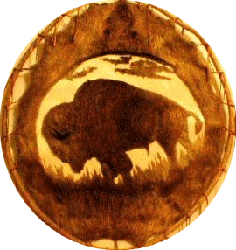
The Ute believe that there are many worlds, some of which have passed away, while others are yet to come, and claim that Pokoh, the Old Man, formed the current world through the power of thought. He created every tribe from the soil of the area in which they were to live. Pokoh has a sister, Rainbow, whose breast is bedecked with garlands of flowers.
The Sun and Moon began life as humans. Sun was an evil man who wishes to destroy all life by means of his deadly arrows. Moon was of the opposite temperament. As a result of his unpopularity, Sun's daughters Mercury and Venus were murdered by a party of twenty men. They returned to life, however, after fifty days. Fire was brought to the world by means of lightning, whose strikes produce flint.
In the other worlds, the people have the attributes of different animals: some fly, some swim, some walk on four legs, some creep and some slither like serpents.
